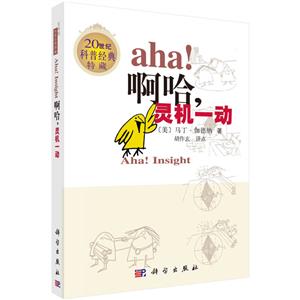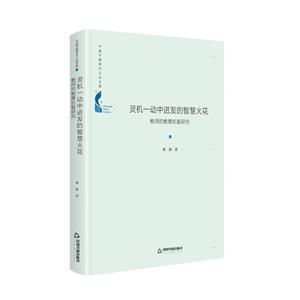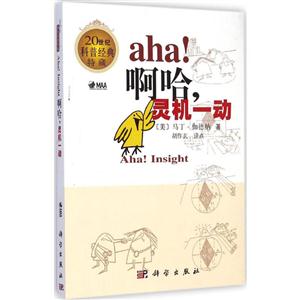
作者:[美]马丁·伽德纳著;胡作玄
页数:268
出版社:科学出版社
出版日期:2022
ISBN:9787030166661
电子书格式:pdf/epub/txt
内容简介
孩子愿意读的英文书不只有哈利波特,还有数学!《啊哈,灵机一动》就是让孩子想一口气读完的英文版数学科普书,原汁原味体味数学乐趣。
目录
序 路甬祥
马丁 伽德纳 胡作玄
戴学游戏帮你学数学 胡作玄
Introduction
前言
Chapter 1 Combinalorial aha! 1
第一章 组合
A Sticky Gum Problem 5
泡泡糖问题
The Ping Pong Puzzle 8
乒乓赛难题
Quibble’s Glasses 10
奎贝尔的玻璃杯
plexing Paths 13
令人困窘的道路
The Bewi1dered Babies 17
搞错了的婴儿
Quibble’s Cups 19
奎贝尔的塑料杯
Steak Strategy 22
炙肉片策略
The Troublesome Tiles 25
难铺的瓷砖
Quibble’s Pets 30
奎贝尔的动物
The Medicine Mix-up Small 33
药品小混
The Medicine Mix-Up Big 34
药品大混
The Broken Bracelet 37
断金链
Chapter 2 Geometry aha! 41
第二章 几何
Crafty Cheese Cuts 45
巧分乳酪
Dimensions in Disguise 49
隐蔽的尺寸
The Big Knight Switch 52
骑士大调动
Suprising Swords 57
奇妙的刀
Payoff at the Poles 60
航空飞行
Quibble’s Matches 66
奎贝尔的火柴
Devilish Divisions 69
巧妙的划分
Miiss Euclid’s Cubes 74
殴几里得小姐的立方体
Carpet Confusion 79
地毯难题
The Curious cake Cut 81
蛋糕的稀奇切法
Chapter 3 Number ahal 85
第三章 数字
Broken Records 89
掰开的唱片
Loch Ness Monster 93
海峡怪兽
One Too Many 95
多余的一个
Eyes and Legs 99
眼睛和脚
The Big Bump 101
撞车事件
Mysterious Merchandise 104
神秘的商品
The Unlisted Phone Number 105
未列入电话簿的电话号码
Hapless Hat 111
倒霉的帽子
Money Matters 115
钱币问题
Uncle Henry’s Clock 117
亨利叔叔的钟
Spirits of 1776 120
1776年的精神
Chapter 4 Logic ahal 127
第四章 逻辑
The Crafty Cabbie 130
狡猾的司机
Color Mates 133
颜色的搭配
Six Sneaky Riddles 138
六则怪谜语
The Big Holdup 141
大盗贼
Dr.Ach’s Tests 145
阿克博士的测验
The Ach Award 149
阿克奖
Holiday Haircut 155
假日理发
Barbershop Bantor 156
理发店的玩笑
Murder at Sun Valley 158
太阳谷的谋杀者
Foul P1ay at the Fountain 161
喷泉边的谋杀
Chapter 5 Procedural aha! 163
第五章 过程
Fifteen Finesse 167
十五的技巧
Hippo Hangup 175
关于河马的难题
Dividing the Chores 179
分配家务
The Crooked Acrobat 182
杂技扒手
Island Crackup 187
飞机坠落于小岛
The Lazy Lover
懒惰的朋友
Sanitary Surgeons 196
外科医生
Chapter 6 Word aha! 201
第六章 文字游戏
Dr.Wally O.Wordle Q4
W.O.沃德尔博士
Shee Lee Hoi 207
西 李 霍
Elusive Eight 209
无从捉摸的“八”(EIGHT)
World’s Smallest Crossword 212
世界上最小的纵横宇谜
Mary Belle Byram 214
玛丽 贝尔 拜伦
Picture puzzles 215
画谜
Crazy Sentences 218
滑稽的句子
Nosmo King 223
可笑的名字
Square Family 225
方卡片中的家谱
Tavern Tease 227
酒馆的招牌
Cryptic Symbols 230
隐蔽的符号
Gold Tuitt 232
镀金的模型飞机
Flo Stuvy 233
弗罗 斯特菲
Curious Sequences 234
奇妙的字母序列
Parting Words 236
最后的话
Answers to Posed Problems 239
答案
节选
Chapter 1 Combinatorial aha! 组合 Puzzles about arrangements Combinatorial analysis, or combinatorics is the study of how things can be arranged. In slightly less general terms, combinatorial analysis embodies the study of the ways in which elements can be grouped into stes subject to various specified rules, and the properties of those groupings. For example, our first problem is about the ways in which differently colored balls can be grouped together. This problem asks the reader to find the smallest sets of colored balls that have certain properties the second problem concerns ways in which players can be grouped on a chart for an elimination tournament—a problem with important counterparts in the computer sorting of data. Combinatorial analysis often asks for the total number of different ways that certain things can be combined according to certain certain rules. The “enumeration problem”, as this is called, is introduced in the episode about the number of ways that Susan can walk to school. In this case, the elements to be combined are the segments of a path along the edges of a matrix. Since geometrical figures are involved, we are in area of “combinatorial geometry”. Every branch of mathematics has its combinatorial aspects, and you will find combinatorial problems in all the sections of this book. There is combinatorial arithmetic, combinatorial topology, combinatorial logic, combinatorial set theory-even combinatorial linguistics, as we shall see in the section on word play. Combinatorics is particularly important in probability theory where it is essential to enumerate all possible combinations of things before a probability formula can be found. There is a famous collection of probability problems called Choice and Chance. in the refers to the book’s combinatorial aspect. 每一章开头的文字一般是十分概括的,事先可以粗看一遍,读完后再仔细领会会更有收获!组合问题有许多,最基本的就是“计数”,也就是每种模式有多少种?这问题看来简单,实际上并不简单,特别是要区分开不同的类型,不要重复计数,也不要漏掉讨数,“完全性”是十分重要的。 Our very first problem concerns probability because it asks for an arrangement of colored balls that makes certain (that is have a probability equal to 1) a specified task. The text suggests how endless other probability questions arise from such simple questions as the number of ways objects can be put together. Enumerating Susan’s paths to school provides a close link to Pascal’s triangle and its use in solving elementary probability questions. The number of arrangements that solve a given combinatorial problem obviously can be none, one, any finite number, or an infinite number. There is no way to combine two odd integers so that their sum is odd. There is only one way to combine two prime numbers so that their product is 21. There are just three ways to combine two positive integers their sum is 7. (They are the pairs of opposite faces on a die.) And there is an infinite number of combinations of two even numbers that have an even sum. Very often in combinatorial theory it is extremely difficult to find an “impossibility proof” that no combination will meet what is demanded. For example, it was not until recently that a proof was found that there is no way to combine the planar regions of a map so that the map requires five colors. This had been a famous unsolved problem in combinatorial topology. The impossibility proof required a computer program of great complexity. On the other hand, many combinatorial problems that seem at first to be difficult to prove impossible can sometimes be proved easily if one has the right aha!insight. In the problem of “The Troublesome Tiles”, we see how a simple “parity check” leads at once to a proof of combinatorial impossibility that would be hard to obtain in any other way. The second problem about the defective pills ties combinatorial thinking into the use of different base systems for arithmetic. We see how numbers themselves and the way in which there are represented in positional notation by numerals depend on combinatorial rules. Indeed, all deductive reasoning, whether in mathematics or pure logic, deals with combinations of symbols in a “ string” , according to the rules of a system that decides whether the string is a valid or invalid assertion. This is why Gottfried Leibniz, the seventeenth-century father of combinatorics, called the art of reasoning an ars combinatoria. A Sticky Gum Problem 泡泡糖问题 这问题是好的数学游戏问题,这表现在它可以推广到更般的情形:①糖的颜色可以是2种,3种, ,n种。②孩子数可以是2人,3人, ,m人8③得种颜色糖各有不同的数目。 How Many Pennies? The second gum ball problem is an easy variation of the first one, and is solved by the same insight. In this case the first three balls could be of different colors~red, white and blue. This is the “worst” case in the sense that it is the longest sequence of drawings that fail to achieve the desired result. The fourth ball will necessarily match one of the three. Since it could be necessary to buy four balls to get a matching pair, Mrs. Jones must be prepared to spend four















